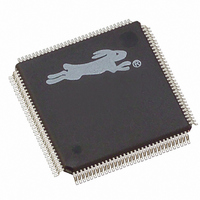20-668-0024 Rabbit Semiconductor, 20-668-0024 Datasheet - Page 345

20-668-0024
Manufacturer Part Number
20-668-0024
Description
IC CPU RABBIT4000 128-LQFP
Manufacturer
Rabbit Semiconductor
Datasheet
1.20-668-0024.pdf
(358 pages)
Specifications of 20-668-0024
Processor Type
Rabbit 4000 8-bit
Speed
60MHz
Voltage
2.5V, 2.7V, 3V, 3.3V
Mounting Type
Surface Mount
Package / Case
128-LQFP
Lead Free Status / RoHS Status
Lead free / RoHS Compliant
Features
-
Other names
20-668-0022
316-1078
316-1078
Available stocks
Company
Part Number
Manufacturer
Quantity
Price
Company:
Part Number:
20-668-0024
Manufacturer:
Rabbit Semiconductor
Quantity:
10 000
- Current page: 345 of 358
- Download datasheet (4Mb)
B.2 Bugs
The following bugs have been identified in the Rabbit 4000 design, and are present in all
devices currently available.
1. Primary/secondary watchdog timer interaction — if the secondary watchdog timer
2. Stack protection/DMA interaction — when stack protection is enabled and a DMA
3. DMA/HDLC/Ethernet interaction — a specific bug can manifest itself when the
Appendix B Rabbit 4000 ESD Design Guidelines and Bug Workarounds
is enabled when a primary watchdog timeout occurs (resetting the processor), the sec-
ondary watchdog timer is still enabled when the device comes out of reset, which is not
the documented behavior (the secondary watchdog should be disabled on reset).
The BIOS provided by Rabbit Semiconductor in Dynamic C avoids this bug by disabling
the secondary watchdog on startup or reset by writing 0x5F to WDTCR. The secondary
watchdog timer is then enabled if needed with the
macro.
transfer is occurring, the stack protection interrupt will occur if the lower 16 bits of a
DMA transfer’s physical write address match the 16 bits of the stack protection’s logical
address limits.
following conditions are present.
When all these conditions occur, the DMA will overwrite the next-to-last byte in the
transmit FIFO, and that particular byte will never be transmitted.
There are several ways to avoid this bug.
The Ethernet driver provided by Rabbit Semiconductor in Dynamic C is written so that
this bug never occurs.
• The HDLC or Ethernet peripherals are being fed bytes for transmit via DMA.
• The current DMA buffer has been marked with “special treatment for last byte.”
• The buffer has not been marked as “final buffer.”
• The DMA fills the transmit FIFO with the next-to-last byte of the buffer and then either switches to
• The DMA then returns to the channel before the transmitter has had a chance to transmit a single
• Always mark the buffer that contains the end-of-frame byte as the final buffer, and restart the DMA
• Make sure that the DMA will not return to this channel before the transmitter has sent one byte
• Place the end-of-frame byte in a separate DMA buffer.
another channel or releases the bus.
byte, freeing space in the transmit FIFO.
once that buffer has been transmitted.
from the transmit FIFO.
#define USE_SECONDARY_WD
335
Related parts for 20-668-0024
Image
Part Number
Description
Manufacturer
Datasheet
Request
R

Part Number:
Description:
IC CPU RABBIT2000 30MHZ 100PQFP
Manufacturer:
Rabbit Semiconductor
Datasheet:

Part Number:
Description:
IC MPU RABIT3000A 55.5MHZ128LQFP
Manufacturer:
Rabbit Semiconductor
Datasheet:

Part Number:
Description:
Microprocessors - MPU Rabbit 3000 TFBGA Microprocessor
Manufacturer:
Rabbit Semiconductor

Part Number:
Description:
Microprocessors - MPU Rabbit 4000 LQFP Microprocessor
Manufacturer:
Rabbit Semiconductor

Part Number:
Description:
IC, I/O EXPANDER, 8BIT, 40MHZ, TQFP-64
Manufacturer:
Rabbit Semiconductor

Part Number:
Description:
SCRs 1.5A 200uA 400V Sensing
Manufacturer:
Littelfuse Inc
Datasheet:

Part Number:
Description:
CARD 6-RELAY SMARTSTAR SR9500
Manufacturer:
Rabbit Semiconductor
Datasheet:

Part Number:
Description:
WIRE-BOARD CONN RECEPTACLE, 6POS, 3.96MM
Manufacturer:
TE Connectivity
Datasheet:

Part Number:
Description:
ADAPTER 20 PIN .420" PLUGS(6PCS)
Manufacturer:
Logical Systems Inc.
Datasheet:

Part Number:
Description:
CONN BARRIER BLOCK .438" 20 POS
Manufacturer:
Cinch Connectors
Datasheet:

Part Number:
Description:
20 MODII 2PC HDR DR SHRD, ROHS
Manufacturer:
TE Connectivity
Datasheet:

Part Number:
Description:
WIRE-BOARD CONN RECEPTACLE, 6POS, 3.96MM
Manufacturer:
TE Connectivity
Datasheet:














